Blog Post
Retail Peak Hours Are Critical in Driving Store Performance
June 7, 2021 in COVID-19, Performance Management, Thought Leadership

The last year has sparked many changes in the retail landscape. Retailers were quick to adapt to changing customer expectations and behaviors. Customer shopping patterns were adjusted due to capacity restrictions, shortened store hours and customer lifestyle changes.
As a result, some traffic shifted from weekends to weekdays; however, weekends continue to remain the busiest days of the week. There was also a shift in more customers shopping during the weekdays over the lunch hours or 12-2pm segment. As some retailers continue to see reduced traffic it is important to remember that peaks are still occurring and continue to have the greatest impact on stores achieving their weekly sales targets.
The 50/20 Rule
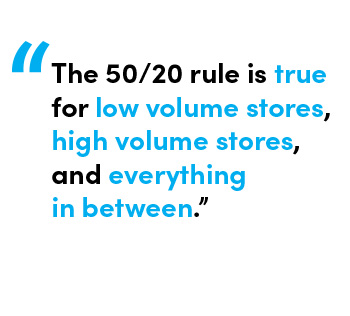
Stores continue to see about 50% of their week’s total traffic and total sales in the busiest 20 hours of the week. While the 50/20 rule may vary slightly from store to store or retailer to retailer, observing and analyzing retail store performance over many years and many clients has consistently proven the 50/20 rule. This is true for low-volume stores, high-volume stores, and everything in between. And although each store may have differing peak segments, they are always changing, so a constant analysis is needed to ensure that the peak segments are properly forecasted and staffed appropriately. This is the most effective way to drive top-line performance.
Changing Peak Patterns
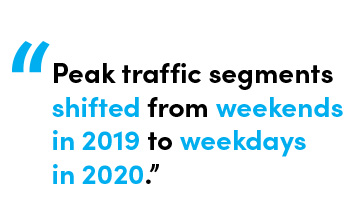
Despite an overall reduction in traffic in 2020, the percentage of weekly traffic that fell on peaks went up from 46% in 2019 to 51% in 2020, making the 50/20 rule even more relevant. In addition, the percentage of weekly sales that fell on peaks went up from 47% in 2019 to 53% in 2020. This is due to a more focused customer. There was a lot of uncertainty around what would be open and closed, and people took the opportunity to purchase (and sometimes in bulk) when they went out. This drove increases in both Conversion and Average Transaction.
Across all 7 days of the week, afternoons had a 14% increase in traffic and evenings had a 16% decrease in traffic. These changes were driven by consumers having more flexibility in their day due to an increase in work from home, and the decrease in the later hours influenced by compressed store hours. Further, some peak traffic segments shifted from weekends in 2019 to weekdays in 2020.
The Shift from Weekends to Weekday Peaks
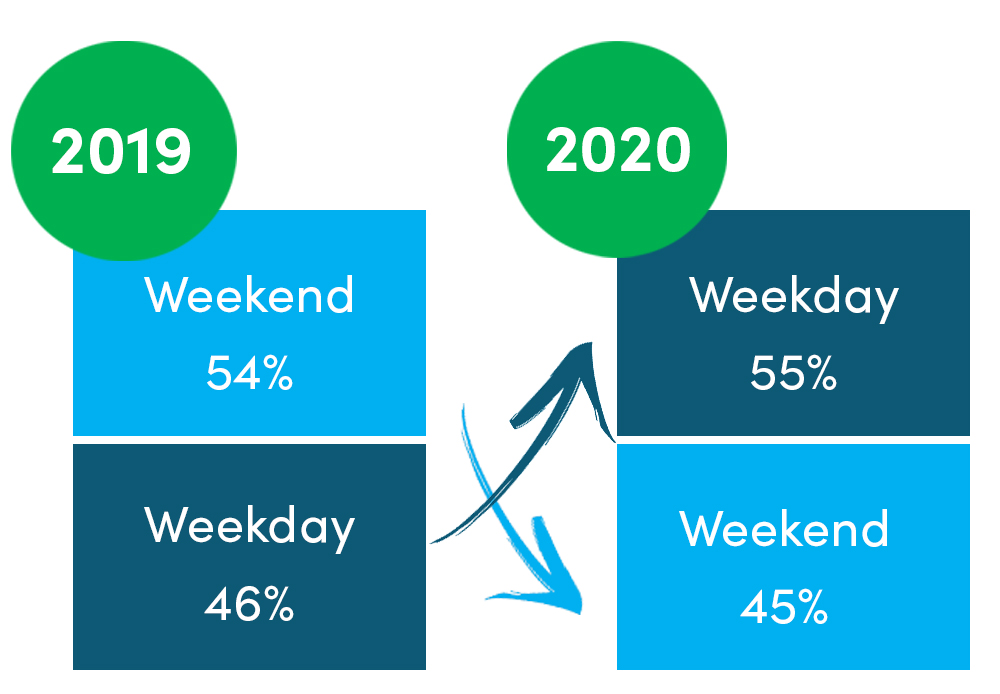
2021 Early Indications Show Peak Traffic Patterns Returning Back to “Normal”
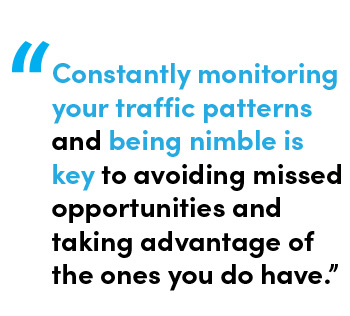
Early indications in 2021 show that peak segments are shifting back toward weekends, or what was considered “normal” before 2020. Peaks are always changing, either due to holidays, time of year, or other events. The pandemic, in contrast, aggravated a shift in peaks more rapidly than we’ve seen in recent history. This is further evidence that retailers must be nimble and pay attention to shifting peaks as they change.
Keeping your finger on the pulse at all times is critical. Constantly monitoring your traffic patterns and being nimble is key to avoiding missed opportunities and taking advantage of the ones you do have. “It’s trying to hit a moving target all the time. So, how do you manage when the targets are constantly moving? Well, you have to be nimble, you have to be able to make those adjustments,” explains StoreForce client, David Tannous, VP of Analytics at Shoe Palace.
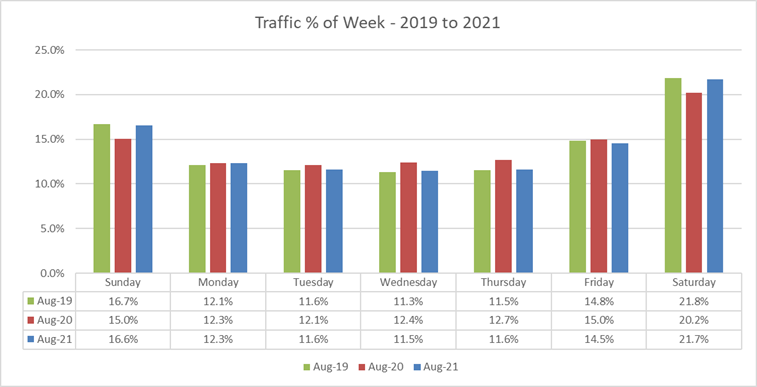
Specialty retailers are diverse. They vary in volume, store size, product assortment, and many other factors. However, they all share one thing in common – the 50/20 rule.
Retailers that increased peak coverage by 10% saw an increase in Swing by 4-6%. Continued analysis has proven that a store’s ability to schedule to peak has a direct correlation to KPI’s such as Swing, Visit Value, Conversion and Average Transaction. In essence, what this means is that, for no additional spend, retailers can achieve an improvement of 4-6% in sales by addressing simple gaps in peak coverage.
Constantly monitoring to know when your peak segments occur, and protecting those top 20 hours by scheduling to recommended coverage are the first steps in winning at peak and driving top-line performance.
StoreForce can help you to achieve your retail goals and labor planning effectiveness. Interested in learning more? Contact us and engage with one of our retail experts as to how we can future proof your overall retail store management.
Author:

Allie Gratton is the Client Services Director at StoreForce. In her role, she interacts with client resources to provide guidance and input on how StoreForce can support their operational initiatives and build relationships with various levels of the client’s organization. She plays a direct role in opportunity identification, training, creation of program materials, and development of results reporting. Allie previously held various roles with a Canadian Specialty Retailer. Throughout these roles, she acquired significant experience and knowledge in managing sales teams and operating retail stores.

Recent Blog Posts

Insights from Industry Leaders at Retail Technology Show 2024
The Customer Experience Drives UK Retailers! There was a buzz in the air last week in London Retail Technology Show 2024 was crackin' with retailers looking for new solutions and...
READ MORE
The Top 7 Questions Asked at the Fabletics Road Show
The StoreForce Road Show was a fantastic event, bringing together retailers from all over Los Angeles County for breakfast and a lively discussion session with Fabletics’ Senior Director of Retail...
READ MORE
Future Stores 2024: Key Takeaways from StoreForce
Future Stores 2024 was an incredible event for brick-and-mortar retail, bringing together industry leaders to discuss and explore the latest trends and innovations As a participant, StoreForce...
READ MORESchedule a Consultation With Our Retail Experts Today
Contact us today for a 15-minute conversation on how StoreForce can help you drive store performance and execution for less than the cost of 1 transaction per week. Learn how retailers all over the world are driving performance and customer experience through our solution made exclusively for Specialty Retail.